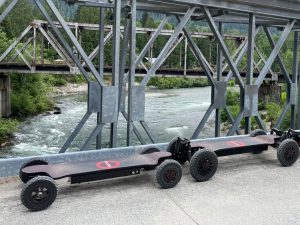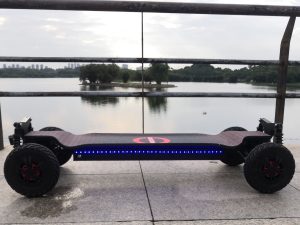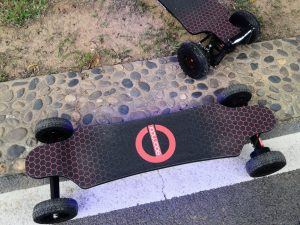Quick answer: An electric skateboard motor uses electromagnets to create rotation and movement. The motor has two main parts – the stationary stator and the rotor, which spins. The stator has coiled electromagnets powered by the battery. The rotor has magnets attached to the central shaft. So, in short, the motor uses magnetic forces to convert electricity into rotational motion. This innovative use of magnets allows electric skateboards to drive themselves without pushing!

Introduction
Electric skateboards have surged in popularity recently as a fun, eco-friendly form of urban transportation. But how do these futuristic-looking boards propel riders down the street without pushing? The secret lies in the electric skateboard’s motor. This innovative motor allows riders to reach speeds of 15-25 mph with just the twist of a throttle.
Understanding the inner workings of the electric skateboard motor helps explain how these self-propelled boards achieve such impressive performance. We’ll explore the motor’s key components and how it generates rotational force to power the wheels.
Stator and Rotor – The Heart of the Motor
The heart of the electric skateboard motor is the stator and rotor. The stator consists of stacked electromagnetic coils surrounding a central cavity. When electricity from the battery enters the engine, it energizes these coils to become electromagnets.
Inside the stator’s cavity spins the rotor, a series of electromagnetic coils. The rotor is mounted on a shaft that exits the motor to transfer power to the wheels.
The key to generating continuous rotation is the interacting magnetic fields between the stationary stator and the rotating rotor. As alternating current alternates the polarity of the stator electromagnets, it creates a pushing and pulling effect on the rotor magnets, causing the rotor to spin in a fixed direction.

Generating Torque Through Magnetic Polarity Shifts
The alternating current supplied to the stator creates a continuously shifting magnetic field. As the polarity of the stator magnets changes, it generates an attractive and repulsive force with the rotor’s magnetic field.
This magnetic interaction applies torque on the rotor assembly, pushing and pulling it to rotate the shaft. With each cycle of alternating current, the rotor turns incrementally, producing a smooth, continuous spinning motion.
The faster the current alternates in the stator, the quicker the rotor spins, producing higher rotational speeds. Electric skateboard circuits can regulate the rotor’s rpm to achieve different speed outputs by precisely controlling the electricity in the motor.
The rotational kinetic energy is transmitted through the rotor shaft and eventually to the wheels, propelling the e-skateboard forward.
Focus on the Speed Controller’s Role in Modulating Output
An electric skateboard’s speed controller circuit is key to modulating motor output. Based on input from the handheld remote, the speed controller regulates the amount of current delivered to the motor.
More current results in faster switching of the stator magnetic fields, increasing rotor rotation and wheel speed. Less current slows the rate of magnetic switching and rotor motion, reducing speed.
Varying torque is also important for acceleration and braking. More torque helps overcome inertia from a standstill to get the board moving. Lower torque allows the motor to slow down and stop when needed.
Configuring the Motor for Optimal Power Transfer
Electric skateboard motors come in two main configurations – hub motors or belt drive motors.
- Hub motors are embedded directly inside the wheel. The rotor shaft links directly to the wheel axle, eliminating the intermediate power transfer. Hub motors provide direct drive with good low-end torque. However, they are exposed to more vibrations and stresses.
- Belt drive motors are mounted on the truck hangers below the deck. A timing belt transfers power from the motor pulley to the wheel pulley. Belt drives allow for gearing ratios to customize speed and torque. But they have higher maintenance needs.
Both types employ the same electromagnetic principles to generate motion. But placement affects overall riding dynamics and feel.

Additional Motor Features
Electric skateboard motors incorporate several other engineering elements to optimize functionality:
- Gearing ratios – Higher ratios prioritize torque over speed and vice versa.
- Sensored vs. sensorless – Sensored motors use sensors for precision position tracking to enhance low-speed control.
- Regenerative braking – Motors can charge the battery by harnessing energy while braking.
These features allow fine-tuning the motor’s power delivery and braking for specific riding purposes.
Conclusion
Electric skateboard motors represent an innovative use of electromagnetic principles to power a new era of compact transportation. By coordinating the interaction of stator and rotor magnets, these motors can propel riders at up to 25mph. Key components like the speed controller and precise motor placement enable performance tuning and handling improvements. While deceivingly simple on the outside, electric skateboard motors utilize advanced inner engineering to drive the wheels of these game-changing boards. Understanding the inner workings of these motors opens up possibilities for further innovation and refinement.
Read More
- Electric Longboard Skateboards With Lights Safety And Style – Ecomobl
- Master Emergency Braking On Electric Skateboard – Ecomobl
- All Terrain Electric Skateboards Gaining Popularity – Ecomobl
- Electric Longboard Price Guide – Ecomobl
- All Terrain Electric Skateboards Features – Ecomobl




